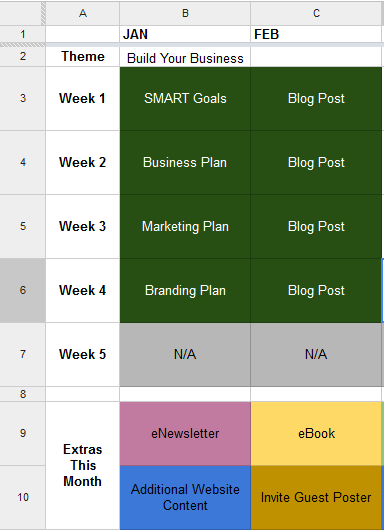“Where do I even start? I’m overwhelmed!” …is this you?
Even if you understand how content marketing is crucial for the ongoing success of your business and your brand, actually creating a content marketing plan for 2014 can be a totally time-consuming task. You might envision creating a slew of blog posts, eBooks, eNewsletters, new website content like articles and whitepapers, social media updates, and more. Now that takes a lot of planning—and that’s just the written content marketing pieces!
So if you’re serious about launching a real content marketing strategy to extend your brand reach this year, there’s just NO way you’re going to be successful without a workable plan in place.
1. Start SMART
What are your content marketing goals? Are they Specific, Measurable, Attainable, Relevant, and Time-Bound? Setting goals using these guidelines allows you to both stick to your SMART goals and, more importantly, to know when you’ve achieved success. Your content marketing goals should be in line with your overall marketing strategy.
For example, if your one of your marketing strategy goals reads, “Extend brand reach by increasing email marketing opt-ins by 10,000 current/potential customers,” some of the content marketing components of that overall marketing goal might include SMART goals such as:
- Add a well-branded email opt-in sign-up section/call to action to company blog by February 15th.
- Create and publish one blog post per week, every week in 2014. Write content two months in advance to stay on schedule.
- Publish 4 free and original, company-branded eBooks in 2014, one each quarter. With each release, create new call to action section on website, and announce release on social media 16 times over 4 weeks.
You’ll probably include more SMART goals to achieve that larger marketing goal. List as many as necessary. THEN, you’ll want to break down each of these goals into even smaller, more bite-sized goals to be achieved each week.
2. Lay It Out & Make It Pretty
This isn’t as silly as it sounds, trust me. Open an Excel document or Google Drive spreadsheet. Across the top of each column, write in the months of the year. Then down the first column, write out days 1 through 31. Now you have a box on your spreadsheet for every day of the year. (If your content marketing plan is smaller, you can do this by weeks instead of days, like the example pictured here.)
List your content marketing deliverables and color code each by type: blog posts might be green, eBooks orange, social media updates purple, etc.
Fill in your content marketing deliverables in the specific boxes on your grid. According to the sample above, 52 squares should list blog posts, 4 squares should be eBooks, and 16 squares (over 4 weeks) should be eBook social media updates. If you’ve already brainstormed on your blog posts and eBooks for the year, or even for the first quarter, go ahead and fill in the exact titles of each of those post and eBook names. (This is just one reason color coding is helpful.)
If you’re not comfortable with your spreadsheet abilities or you need something a little more complex, there are quite a few examples online, so you can find a style and layout that suits your business best. Try this free download from Attract Customers Now or simply do a Google search for “sample marketing calendar” and you’ll see a variety of examples.
3. Assign Your Team To-Dos
There are several ways to do this. Oftentimes, simply inserting initials right into your lovely color-coded grid makes the most sense. If you’re a smaller company, this might not be necessary, as you may only have one person responsible for each set of deliverables. Either way, your team now has a standard grid they can reference to be sure everyone’s on the same page as the year progresses.
If you need to assign multiple people to each project and break down each phase, an all-out project plan will be required for each deliverable. More complicated projects, like eBooks, should have their own associated planning document (which you can link to right within your grid as well—handy!), detailing out each step: research, write, edit, add call-outs, brand, design, finalize and send, with each step assigned to a specific person or team.
“AHH! I’m Still Overwhelmed!”
This is common. Do not be alarmed! It CAN be done—but hey, no one’s a superhero here. Typically, the average business owner might look over this guide and think, “I just don’t have time for that.” Really, who does? It might be time to enlist a marketing team and/or content marketing development company to help strategize, then formulate, schedule and/or create your content marketing components.
Your content marketing strategy is an important extension of your brand (now more than ever!), so you shouldn’t just hand it off to the intern and say, “Write up some blogs and Facebook posts.” If you value your brand and your business, it’s worth taking the time to create a content marketing plan. Your brand depends on it!
